North American F-100 Super Sabre Development, Deployment & Photographs
General Design Characteristics of the F-100 Super Sabre
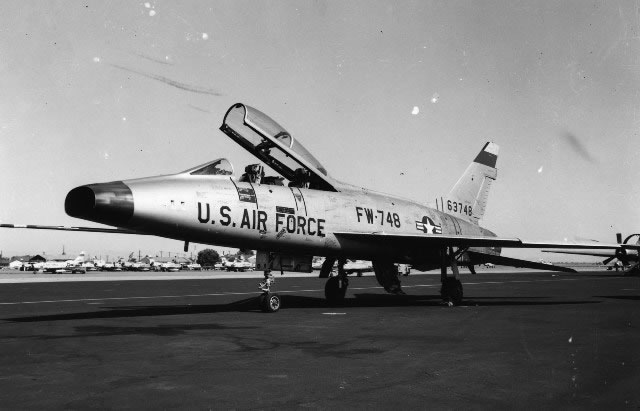 North American F-100 Super Sabre S/N 63748, Buzz Number FW-748 |
The F-100 Super Sabre was a swept-wing supersonic jet that served in the U. S. Air Force from 1954 to 1971; it remained active in the Air National Guard until 1979.
The F-100 was the first Air Force jet fighter plane capable of supersonic speed in level flight. In addition to its nuclear bomb armament and four 20 mm cannons, the Super Sabre could be equipped to fire rockets and missiles, including the heat-seeking the GAR-8 Sidewinder. The F-100 had a service ceiling above 50,000 feet and a range of more than 1,000 statute miles.
While the later models of the F-100 had a speed in excess of 1,000 mph, earlier "A" and "C" models set a series of supersonic speed records. Colonel F.K. (Pete) Everest reached 755.149 mph in October 1953, and Colonel Horace Hanes topped 822 mph in August 1955.
In addition to the thin, highly swept wing and tail, the F-100 design incorporated other features that reflect an answer to the problem of supersonic flight. Heat-resisting titanium was used extensively throughout the plane.
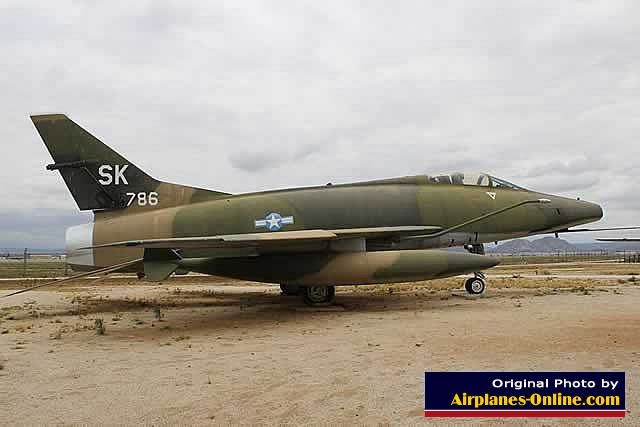 F-100C Super Sabre, S/N 54-1786, Tail Code SK, on display at the March Field Air Museum in California |
A low-drag, ultra-streamlined fuselage and canopy with but one thin-lipped air intake duct helped make supersonic speed possible. The canopy line matched the rear fuselage in a smoothly curving line so that from the side, the Super Sabre appeared to be slightly arched. The F-100 was the first Air Force fighter plane to utilize the low tail.
The F-100 was often referred to as "The Hun," an obvious reference to its "one hundred" designation.
F-100 Super Sabre Development and Production
The F-100 began life in January 1951 when North American Aviation presented an unsolicited proposal to the Air Force for a new generation of fighter airplane. Originally named "Sabre 45" because of its 45° wing sweep, it represented a logical evolution of the F-86 Sabre jet.
The Air Force was interested in the concept, and the plane was designated the F-100, with a buzz number of "FW".
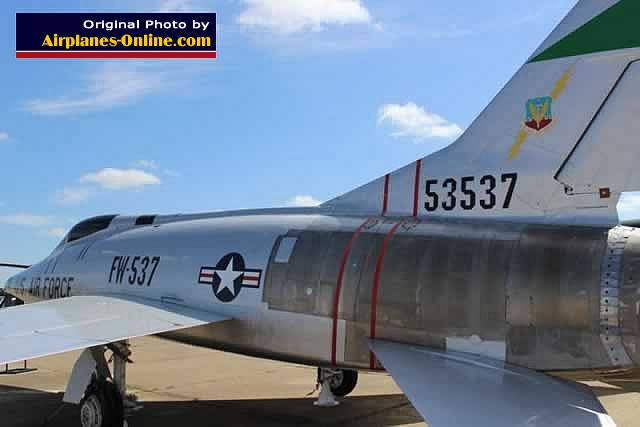 North American F-100A Super Sabre S/N 53-1684 painted as 55-3537, Buzz Number FW-537 |
The YF-100A flew in May 1953 and reached a speed of Mach 1.05. The second prototype flew in October 1953, followed by the first production F-100A on October 9, 1953. Early prototypes and operational units suffered from stability, structural failures, and hydraulic system failures; a number of refinements were incorporated in the aircraft over its lifetime.
The F-100A officially entered Air Force service on September 27, 1954. The Tactical Air Command (TAC) requested a fighter-bomber variant of the aircraft, and North American thus produced the F-100C, which flew in March 1954 and entered service in July 1955.
The next model, the F-100D, was designed to address the offensive shortcomings of the F-100C by being primarily a ground attack aircraft, with fighter capability a secondary objective. The F-100D was fitted with autopilot, upgraded avionics, and in later production models a Sidewinder capability. The F-100F two-seat trainer entered service in 1958.
Another development was the F-100B model, later changed to the North American F-107 Ultra Sabre.
Deployment of the F-100 Super Sabre
 During its service career, the F-100 was deployed around the world, from Europe to Africa to Asia. It saw extensive service during the Viet Nam War.
During its service career, the F-100 was deployed around the world, from Europe to Africa to Asia. It saw extensive service during the Viet Nam War.
In 1961, at England AFB, Louisiana, the 401st Tactical Fighter Wing was equipped with four fighter/bomber squadrons of F-100s: the 612th, 613th, 614th and the 615th (Fighting Tigers). During the Berlin Crisis, the 614th was deployed to Ramstein Air Base, Germany to support the West Germans.
During its service career, hundreds of F-100s were lost in crashes. The F-100 was the subject of many modification programs over the course of its service, including improvements to electronics, structural strengthening, and projects to improve ease of maintenance.
End of Service Life for the Super Sabre
By 1972, the F-100 had been effectively phased out of active US Air Force service, with remaining F-100s assigned to Air National Guard tactical fighter groups and squadrons. It also saw service in the air forces of several other countries.
A total of 2,294 F-100s would ultimately be built.
Surviving F-100 Super Sabre Aircraft
Over thirty F-100 aircraft have been saved, restored and are on static display in the United States. Others are on display in other countries, such as the one on display at Les Ailes Anciennes Toulouse, France.
The Airplanes Online staff has had the opportunity to view several of these, including those shown in the photos below.
The F-100F Super Sabre S/N 56-3844 named "Misty 1" is in flying status with the Collings Foundation’s Vietnam Memorial Flight Collection and Programs at Ellington Field, Houston Texas. The jet is painted in honor of Col. Bud Day, a Vietnam era POW ... see video below for Col. Day's flight in the F-100.
Photographs of Surviving F-100 Super Sabres
North American F-100 Super Sabre in Atwater, California S/N 53-1709 (displayed as F-100D -- 55-2789) |
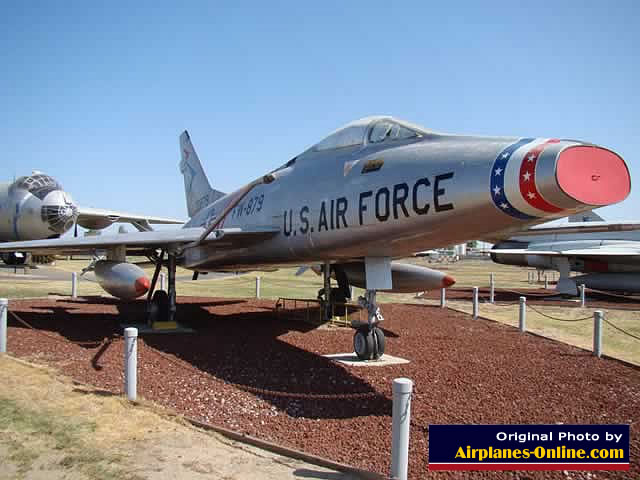 |
North American F-100 Super Sabre, S/N 54-1986, at Eglin AFB, Florida |
 |
F-100D Super Sabre, Serial Number 55-3503, Tail Code SS, Pueblo Weisbrod Museum |
 |
F-100D Super Sabre, S/N 53-503 |
 |
F-100C Super Sabre, S/N 54-1786, Tail Code SK, on display at the March Field Air Museum in California |
 |
F-100A Super Sabre, S/N 52-5777,
Buzz Number FW-777, at the Hill Aerospace Museum, Ogden, Utah |
 |
North American F-100A Super Sabre S/N 53-1684 at the Historic Aviation Memorial Museum in Tyler Painted as 55-3537 FW-537 to resemble the F-100D flown in Viet Nam by Lt. Col. Paul N. Cohagan, in his memory; restoration funds were provided by the Cohagan family Read an article about the restoration of this F-100 |
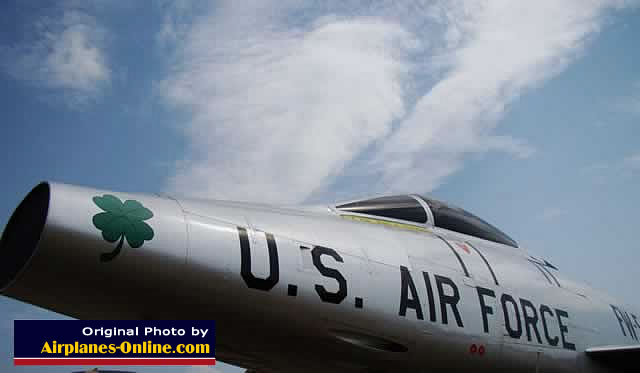 |
North American F-100A Super Sabre 53537 |
 |
North American F-100A Super Sabre S/N 53-1684 painted as 55-3537, FW-537 |
 |
F-100A Super Sabre S/N 52-5761 at the New England Air Museum |
 |
North American F-100F Super Sabre S/N 56-3837 at the National Museum of the U.S. Air Force |
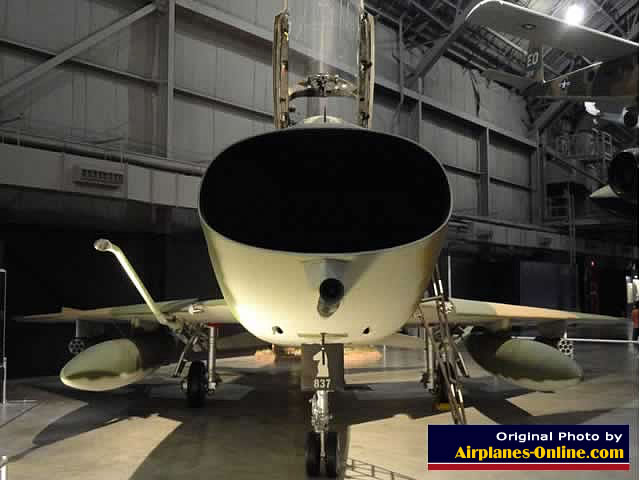 |
North American F-100C Super Sabre, S/N 54-1823, restored at Tucson |
 |
F-100A Super Sabre, S/N 53-1553, outside the gate of Ellsworth AFB |
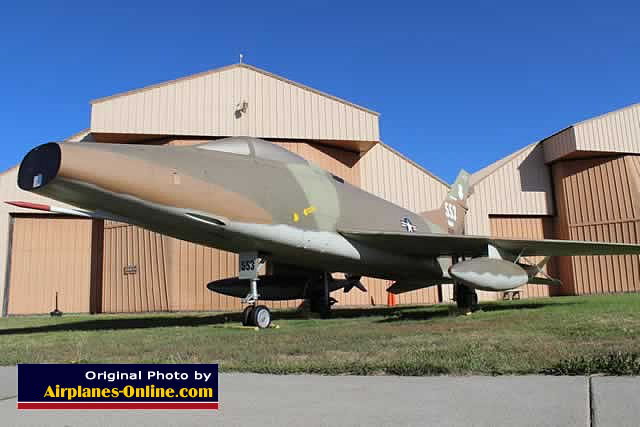 |
F-100 Super Sabre S/N 63880 in storage at AMARC Lt. Col. Gene Gaddis still painted on the fuselage |
 |
Newspaper Clipping:
A pilot identified at Colonel Daniel steps down from the cockpit of an F-100 at England Air Force Base in May of 1957 |
 |
Surviving F-100 Super Sabre Photographs by Airplanes Online Friends and Supporters
F-100D Super Sabre, S/N 54-2163, at the Dumfries Aviation Museum in Scotland. The jet fighter was in service by the French Air Force from 1958 before being returned to U.S. control at RAF Sculthorpe in 1977. (Photo by and courtesy of Draken Modelling) |
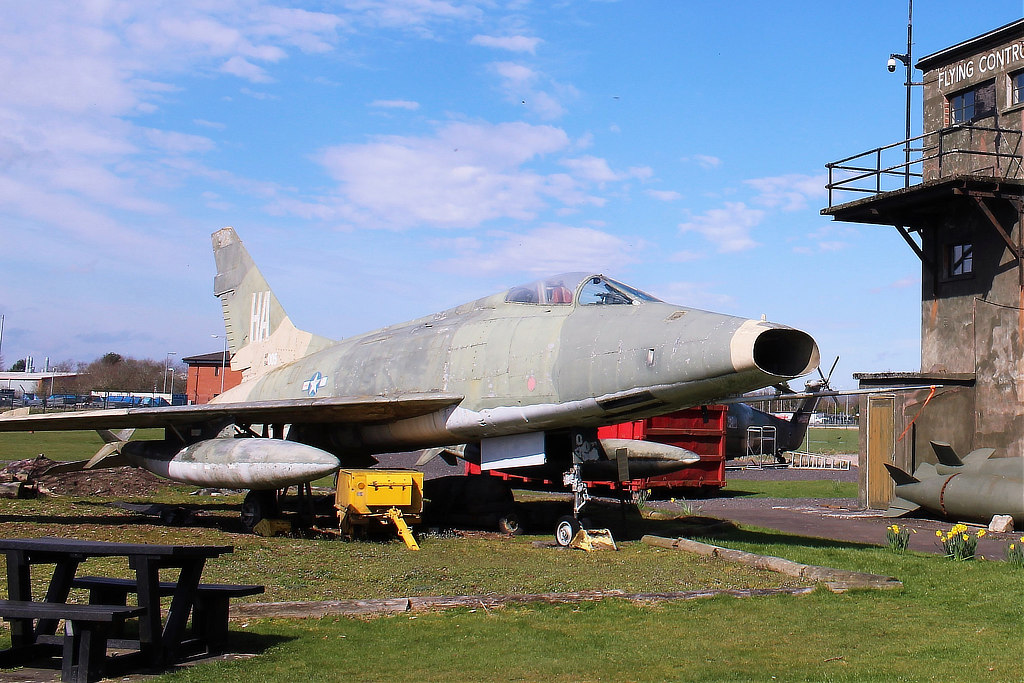 |
F-100 Super Sabre, S/N 54-2239, Buzz Number FW-239, at Les Ailes Anciennes Toulouse, France, in 2010. The Armee de l'Air was the first Western-aligned air force to receive the F-100 Super Sabre. The first aircraft arrived in France in May of 1958. A total of 100 aircraft (85 F-100Ds and 15 F-100Fs) were supplied to France, and assigned to the NATO 4th Allied Tactical Air Force. (Photo by DELEHELLE Eric) |
 |
F-100A Super Sabre, S/N 41897, Tail Code VS, at Buckley Air Force Base, Aurora, Colorado (photo by Michael Hoschouer) |
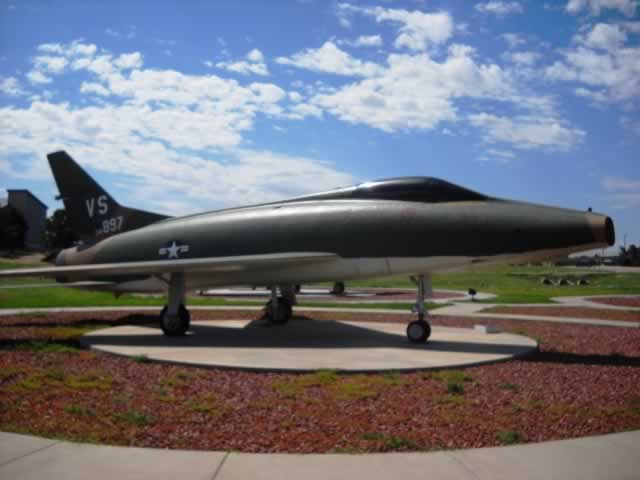 |
F-100F Super Sabre, S/N 56-3832, Evergreen Aviation & Space Museum, McMinnville, Oregon (photo by Michael Hoschouer) |
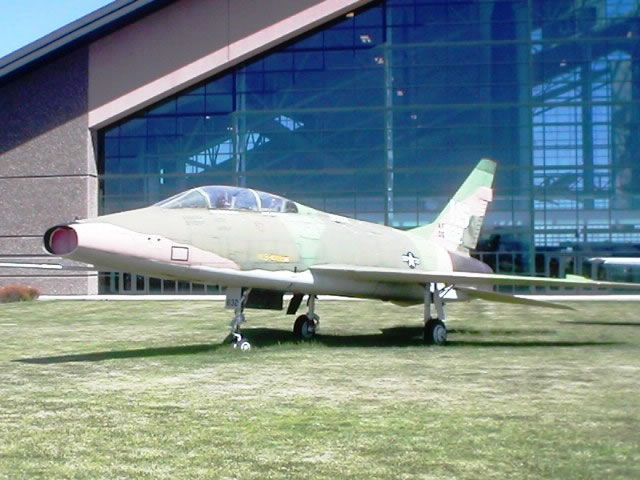 |
F-100A Super Sabre, Buzz Number FW-755, Edwards Air Force Base, California (photo by Michael Hoschouer) |
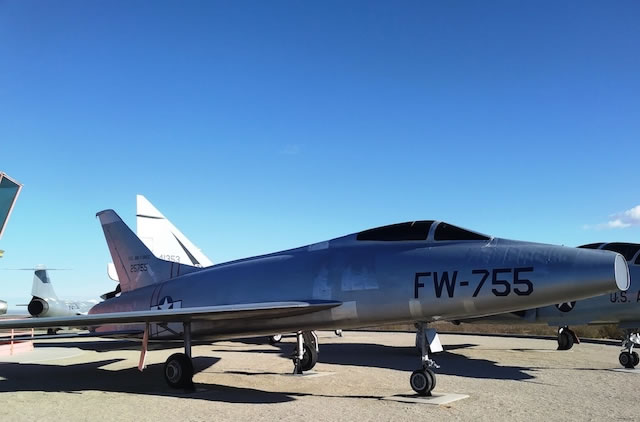 |
F-100D Super Sabre, S/N 42299, in the USAF Thundebird colors, Palmdale, California (photo by Michael Hoschouer) |
 |
F-100F Super Sabre, S/N 56-3727, Tail Code HE, Warrior Park, Davis-Monthan AFB, Tucson, Arizona (photo by Michael Hoschouer) |
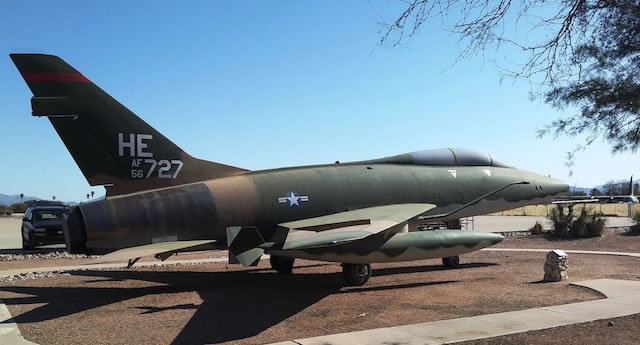 |
F-100D Super Sabre, S/N 56-3220, Holloman AFB, New Mexico (photo by Michael Hoschouer) |
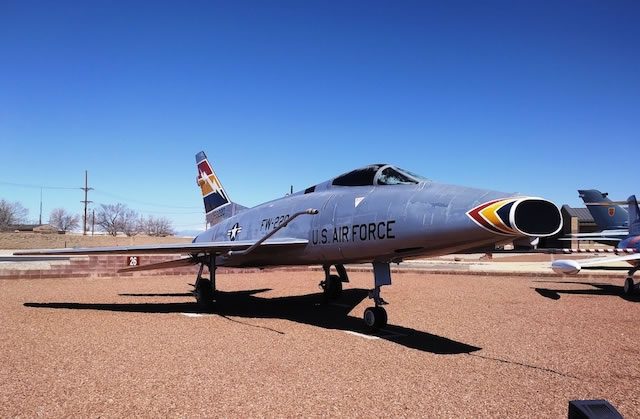 |
F-100A Super Sabre, S/N 53-1532, Kirtland AFB, Albuquerque, New Mexico (photo by Michael Hoschouer) |
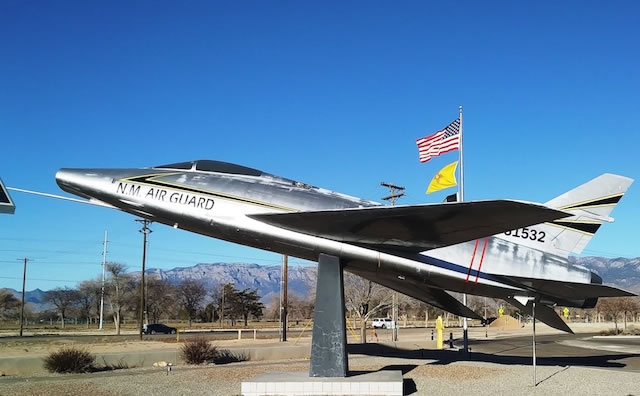 |
F-100C Super Sabre, S/N 53-1716, Tail Code LA, Luke Air Force Base, Phoenix, Arizona
(photo by Michael Hoschouer) |
.jpg) |
F-100D Super Sabre, Aerospace Museum of California in McClellan, CA
(photo by Michael Hoschouer) |
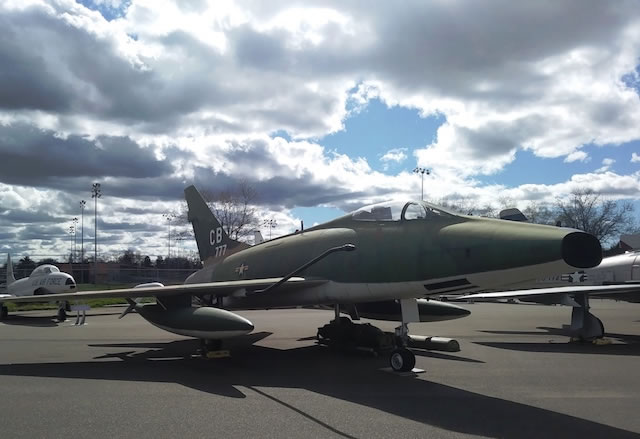 |
F-100D Super Sabre, S/N 56-3417, Buzz Number FW-417, Wings Over the Rockies Air & Space Museum, Denver CO (photo by Michael Hoschouer) |
 |
F-100D Super Sabre, S/N 63299, at Buckley Air Force Base, Aurora, Colorado
(photo by Michael Hoschouer) |
 |
F-100C S/N 53784, Buzz Number FW-784, on display at Mountain Home Air Force Base in Idaho (photo by Michael Hoschouer) |
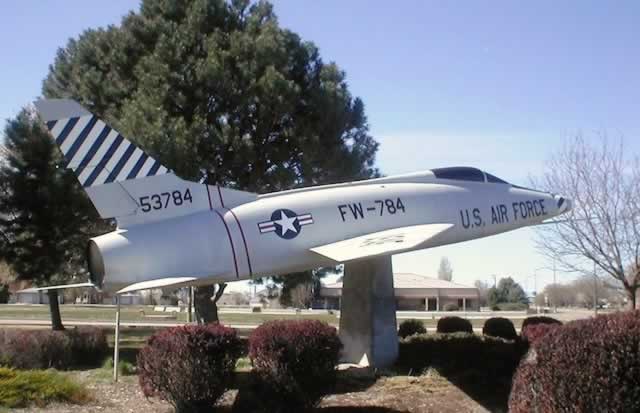 |
A Fascinating Story of Another F-100 Survivor
In 2012, the Military Aviation Preservation Society (MAPS) Air Museum at the Akron/Canton Airport in Ohio completed restoration of an F-100D.
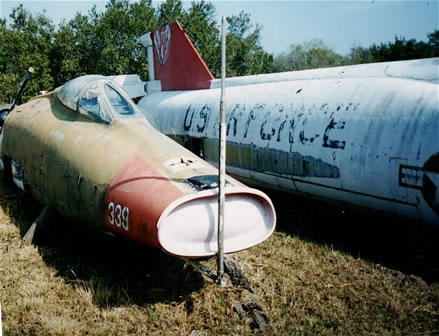 North American F-100D Super Sabre 56-3081 before restoration - Photo by the Military Aviation Preservation Society (MAPS) Air Museum |
In 1967 it was deployed to do what it was designed for – combat. 56-3081 survived 3 years of combat in Vietnam then returned to the states, again for training purposes. In April 1972 it began 6 years of active duty with the Air National Guard in Ohio, Iowa and Missouri The Missouri ANG was the last combat unit to fly 081 as a piloted aircraft.
In the fall of 1978, 56-3081 was sent to the “bone yard” (AMARG) at Davis-Monthan AFB, AZ. It sat there for 10 years before it was converted to a QF-100D drone (#339) in 1988. 56-3081 escaped combat damage in Vietnam but as a drone it was hit with an AIM-9 Sidewinder missile. The missile came from the upper left rear striking the lower edge of the rudder then punching a hole in the left inboard aileron. There was no explosion, probably a guidance only test. Upon landing, the nose gear collapsed grinding off a good portion of the forward lower intake.
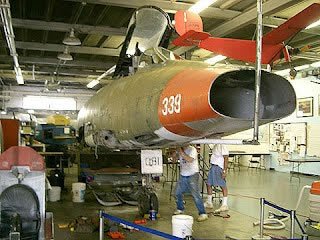 F-100D Super Sabre 56-3081 during restoration Photo from the Military Aviation Preservation Society (MAPS) Air Museum |
The major damage to the aircraft (other than the sidewinder hit) was corrosion. Many years in the Florida salt air took its toll (deep pits in thick skin, holes in thin skin, some panels corroded away). The restoration team headed by Ken Ramsay at MAPS removed the corrosion and filled or replaced the skin. The intake damage was repaired and missing components (pitot boom, air refueling probe, gear doors tail hook, tires, etc.) were obtained.
On Sunday June 17, 2012, MAPS member Ken Ramsay dedicated his 7-year long project. Ken, being a former F-100 pilot, took on the task to restore the plane to static condition. It joins the ranks of the C-47, A7 and F-86D as aircraft that have been restored in the last four years by MAPS members. Visit the MAPS website for more info
North American F-100D Super Sabre 56-3081 with Tail Code VP after preservation at MAPS |
 |
Our Tribute to the F-100
This section of Airplanes Online is meant to be a tribute to those who designed & built the F-100, the crews who flew her, and those who have worked tirelessly to preserve this groundbreaking airplane and its history.
I've had an interest in the fighter jet since I saw my first F-100 Super Sabre in the mid-1950s at an air show at England Air Force Base in Alexandria, Louisiana. It made a low approach just over the runway, and zoomed vertical above the dazzled crowds below.
The excitement I had as a youth when I assembled an Aurora Kit of the F-100 with buzz number "FW-452" markings continues to this day.
North American USAF F-100 Super Sabre S/N 7452, Buzz Number FW-452 Kit No. 490-49, 5/32" Scale Model from Aurora Plastics Corporation (circa 1961) |
 |
USAF F-100 Super Sabre Photos
North American F-100 Super Sabre S/N 63748, Buzz Number FW-748 |
 |
U.S. Air Force F-100 Super Sabre 63992 |
 |
U.S. Air Force F-100 Super Sabre, S/N 63328, Buzz No. FW-328 at takeoff |
 |
Flight formation of four F-100C Super Sabre jet fighters with S/N 42105 in the foreground |
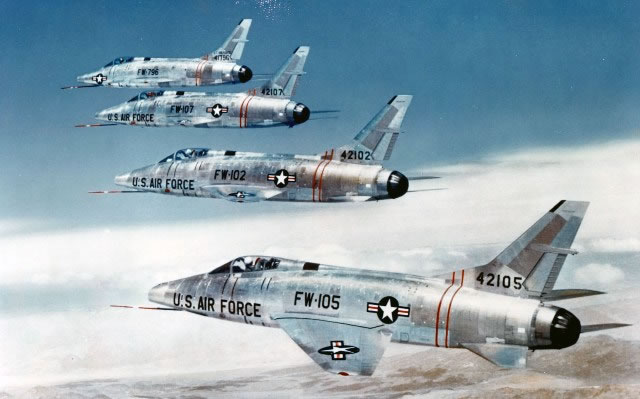 |
F-100 Super Sabre in USAF Thunderbird livery |
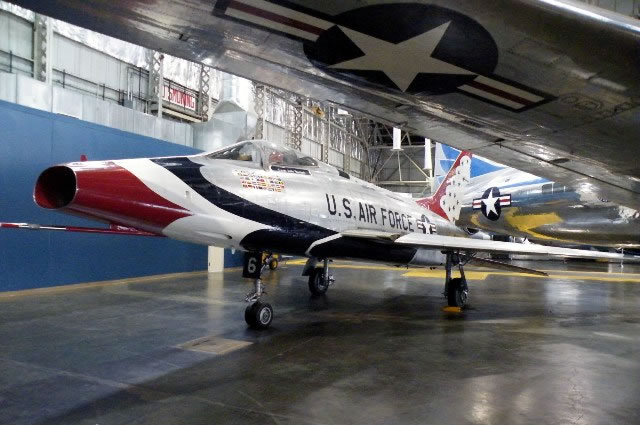 |
F-100 Super Sabre from the Airplanes Online Collection
F-100 Super Sabre S/N 41951 in flight |
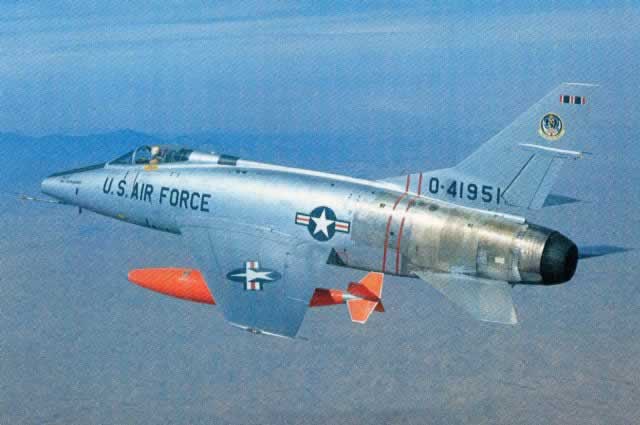 |
More F-100 Resources
| F-100 Super Sabre (F-100.org) |
| Super Sabre Database Project (SuperSabre.com) |
| The Super Sabre Society |
| SuperSabre.org |

